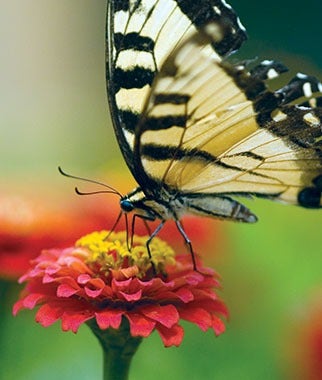We use cookies to give you the best experience on our website. These cookies are completely safe and secure and will never contain any sensitive information. Please read our Privacy Policy. By clicking "Ok" or clicking on any other content, you agree that cookies can be placed.
Butterfly Factory
Every well dressed garden needs a bit of jewelry. Butterflies are jewels in the garden. They
add an extra layer of delight. Sun reflects and sparkles on iridescent, colorful wings as they
flutter above garden plants. Their flight is a glittery dance. Invite butterflies in and
encourage them to stay.
Send butterflies a loud and clear invitation by planting butterfly-friendly flowers in your
garden. Ask them to become long-term residents by providing food and shelter for them.
“Turn your garden into a butterfly factory,” said Kristen Gilpin, curator of BioWorks Butterfly
Garden near Tampa, Florida.
Butterflies have four stages of life. Adults lay eggs on host plants. Eggs become caterpillars
and eventually morph into pupa surrounded by a cocoon. To create a butterfly factory in your
garden, meet the needs of the butterfly during each stage of life.
Adult butterflies feed on nectar. Treat them like the extra special guests they are by planting
flowers with a tubular shape.
“Tubular flowers hold more nectar and hold it more deeply,” said Gilpin, “Color isn’t terribly
important. Planting a wide variety of flowers is.”
Planting flowers that will bloom at different times will provide a steady stream of food to
butterflies in your garden. They like big flower heads or grouping of flowers. Butterflies
flock to favorites like Coneflower, Monarda Bee Balm and Butterfly Bush They love Solidago and
Aster.
“Butterflies also need shelter. Shrubs and tall grasses are good shelters,” said Gilpin.
Different butterflies are attracted to different flowers. Monarchs will only feed on Asclepias
Butterfly Weed or Milkweed. Painted lady butterflies thrive on hollyhock and thistle. Eastern
Black Swallowtail loves Rudbeckia Black Eyed Susan and Buttonbush.
Once the adults are comfortable, they lay their eggs on leaves. The eggs become caterpillars.
The caterpillars eat plants in order to grow into the pupa stage.
“Garden for you and your butterflies at the same time,“ said Gilpin.
Plants please us with their beauty while pleasing caterpillars by being their dinner. A
butterfly gardener embraces dual purpose in garden plants. Gilpin said a good approach is to
grow extra, knowing your caterpillars will chow down on certain plants. Accept a few holes in
leaves for the pleasure of having butterflies.
She suggests carefully moving caterpillars from plants you use and highly desire to those you
grow specifically for the caterpillars.
“If you like dill but not fennel, grow dill next to fennel and transfer the caterpillars to the
fennel,” said Gilpin.
Caterpillars love some of our favorite foods. They love herbs as much as the finest French
chef.
“Parsley, dill, fennel and mint are all good caterpillar food,” said Gilpin.
Dill and fennel’s feathery foliage and spicy fragrance has great ornamental appeal and works
well mixed with flowers in your borders. It’s pretty for us and practical for butterflies.
Mixing herbs in with flowers creates a good environment where butterflies are likely to lay
their eggs. Butterflies will search out and lay eggs on plants that will feed their
young.
White butterflies are drawn to cabbage, kale, and collard and mustard greens. Gilpin said to
grow greens next to your cabbages and move caterpillars from the cabbage for your family to
kale or greens you grow for the caterpillars.
You wouldn’t invite friends over without preparing a snack or meal for them. You’d provide a
nice place for overnight guests to rest. If you do the same for butterflies in your garden,
they’ll reward you daily with their engaging flight and beauty.

